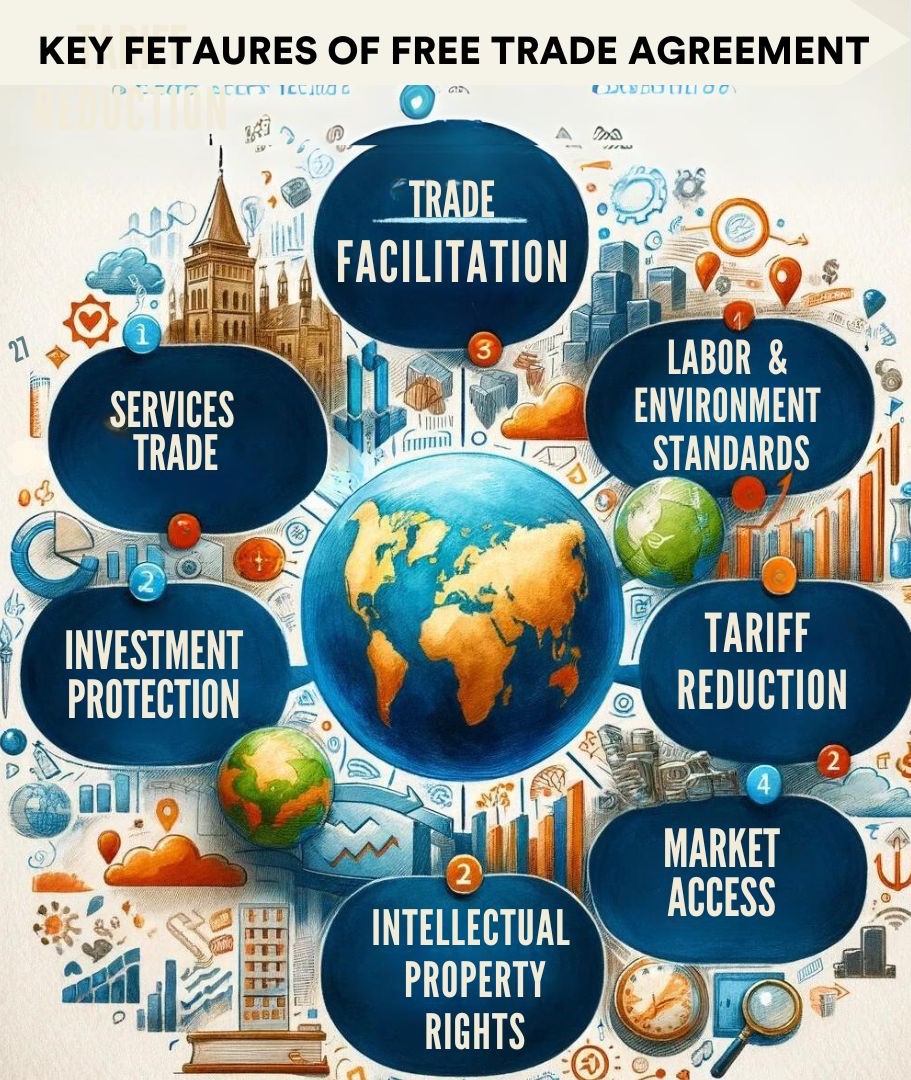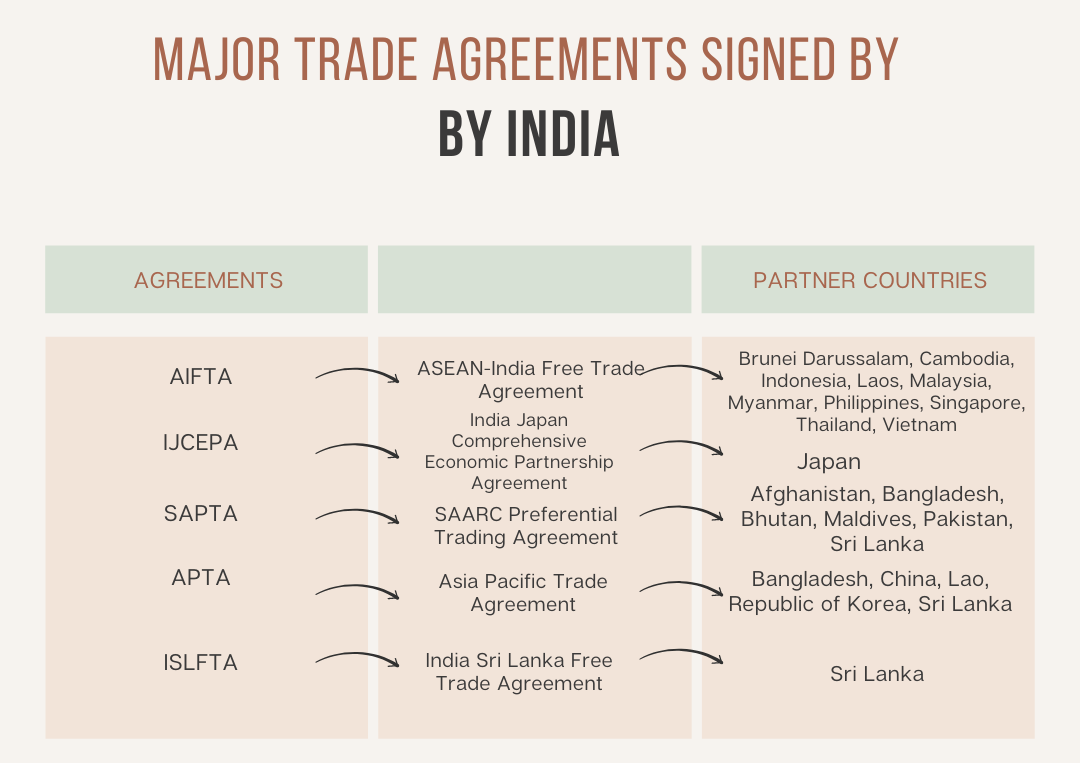
India’s trade landscape took a significant leap with the recent finalization of a trade agreement with the European Free Trade Association (EFTA), which includes Iceland, Liechtenstein, Norway, and Switzerland. This Trade and Economic Partnership Agreement (TEPA) is set to amplify trade between India and the EFTA member states, uniquely focusing on environmental and labor standards. Unlike previous agreements, this FTA stands out with an investment chapter that leans more towards facilitation than mere protection. It promises not just enhanced economic ties but also aims at sustainable development and job creation, marking a progressive shift in India’s approach to international trade agreements. This introduction aims to unpack the essence and implications of this landmark deal, shedding light on its potential to shape India’s economic future.
Background of the EFTA Deal
- Free Trade Agreement Essentials: Understanding what FTAs are and their importance.
- India’s FTA Strategy: Examination of India’s current standing and approach in global trade agreements.
Facts
- India-European Free Trade Association Agreement: India recently finalized a significant trade agreement with the European Free Trade Association (EFTA), which includes Iceland, Liechtenstein, Norway, and Switzerland. This Trade and Economic Partnership Agreement (FTA) is focused on boosting trade and addressing environmental and labor standards, a new direction from past trade agreements.
- Shift in Trade Negotiations: Highlighted by economist Biswajit Dhar, this agreement signifies India’s move towards incorporating environmental and labor considerations into its trade negotiations, aiming for sustainable development among the participating countries.
- Investment and Job Creation: A unique aspect of the India-EFTA agreement is its detailed investment chapter, which deviates from prioritizing protection to facilitation. The EFTA countries aim to increase Foreign Direct Investment (FDI) to India by $100 billion over 15 years and alongside facilitating the creation of one million jobs and establishing an “obligation of conduct” towards these goals.
- Nature of Free Trade Agreements (FTAs): FTAs are designed to reduce or eliminate trade barriers like tariffs and quotas, thus promoting economic integration and increasing trade between the signatories. They typically aim to boost economic growth, create jobs, enhance competitiveness, and provide consumers with more variety at lower prices.
- India’s Existing FTAs: India has several FTAs, including the South Asian Free Trade Area (SAFTA), ASEAN Free Trade Area, and India-Japan Comprehensive Economic Partnership Agreement (CEPA), and is in negotiations with the European Union, among others. These agreements aim to promote trade and economic cooperation by facilitating market access, reducing tariffs, and enhancing investment protection and intellectual property rights.
- India’s Trade Agreement Strategy: India’s strategy in trade agreements includes reducing tariffs, improving market access for goods and services, streamlining customs procedures, protecting foreign investments, addressing intellectual property rights, and liberalizing trade in services. Modern FTAs also incorporate labor and environmental standards.
Issues Involved
The heart of the discussion lies in the nuanced issues this trade agreement seeks to resolve. Traditionally, Free Trade Agreements (FTAs) have concentrated on dismantling tariffs and non-tariff barriers to trade. However, the India-EFTA agreement ventures beyond these confines by integrating environmental and labor standards into the fold. This inclusion marks a significant pivot towards addressing global challenges such as climate change and workers’ rights within the framework of international trade. The detailed investment chapter, with its emphasis on facilitation over protection, further underscores a commitment to creating an ecosystem conducive to sustainable investment flows. By aiming for substantial foreign direct investment and job creation, the agreement endeavors to set a new benchmark for how trade can be leveraged as a vehicle for broader socio-economic development. This progressive approach encapsulates the complex interplay of trade liberalization, environmental stewardship, and social responsibility, presenting a holistic model for future negotiations.
Background of the EFTA Deal
Overview of the EFTA Deal
The trade agreement between India and the European Free Trade Association (EFTA)—including Iceland, Liechtenstein, Norway, and Switzerland—underscores a significant evolution in trade negotiations by emphasizing environmental and labor standards. This pact represents a noteworthy departure from previous agreements, highlighting the evolving priorities in global trade dynamics.
The Significance of the Deal
The EFTA deal is poised to substantially enhance trade levels and economic ties between India and the EFTA countries, fostering an environment conducive to sustainable development. This agreement underlines the importance of integrating environmental and labor considerations into the fabric of trade negotiations, reflecting a modern approach to international trade agreements.
Investment Chapter in the Agreement
The investment chapter of the EFTA deal signifies a strategic shift towards facilitation over protection, with commitments from EFTA countries to increase Foreign Direct Investment (FDI) to India. This approach is expected to stimulate job creation and economic growth, showcasing the deal’s comprehensive strategy to enhance bilateral relations.
Read Landmark Judgment on Common Intention also.
Understanding Free Trade Agreements (FTAs)
Free Trade Agreements (FTAs) are designed to promote economic integration and increase trade by reducing or eliminating barriers such as tariffs and quotas. They aim to foster economic growth, create jobs, and provide consumers with more choices at lower prices, highlighting their significance in the global economic landscape.
Key Features of Free Trade Agreements
Tariff Reduction or Elimination
Reducing or eliminating tariffs is a cornerstone of FTAs, aimed at facilitating smoother and more affordable cross-border trade. This feature is critical for enhancing economic ties and fostering growth among the participating countries.
Market Access
FTAs play a crucial role in improving market access for goods and services, addressing non-tariff barriers that may impede trade. This expanded access is vital for businesses looking to enter new markets and for economies seeking diversification.

Trade Facilitation
Streamlining trade processes and reducing the costs associated with customs procedures and documentation are essential aspects of FTAs. These provisions are aimed at making trade more efficient and less cumbersome for participating countries.
Investment Protection
Investment protection mechanisms within FTAs safeguard foreign investments, ensuring a stable and predictable environment for investors. These protections are crucial for encouraging foreign direct investments and fostering economic cooperation.
Intellectual Property Rights (IPR)
Addressing IPR within FTAs is pivotal for promoting innovation and protecting the rights of creators and innovators. These provisions help maintain a balance between fostering creativity and ensuring access to new technologies and cultural products.
Services Trade
Liberalizing trade in services, including financial and telecommunications services, is a key aspect of modern FTAs. These provisions aim to reduce regulatory barriers and improve market access, contributing to economic growth and development.
Labor and Environmental Standards
Incorporating labor rights and environmental standards in FTAs ensures that economic growth does not come at the expense of worker welfare or environmental protection. These provisions reflect the growing recognition of sustainable development principles in global trade practices.
India’s Position in the Context of Free Trade Agreements
Overview of India’s FTAs
India’s strategic engagement in numerous FTAs with countries and regional blocs highlights its commitment to fostering trade and economic cooperation. These agreements span various sectors and regions, demonstrating India’s proactive approach to integrating with the global economy and leveraging trade for growth and development.
Other Major Trade Agreements Signed by India

List of FTAs/PTAs and Partner Countries
India’s expansive trade network, evidenced by its FTAs and Preferential Trade Agreements (PTAs) with a diverse set of partners, underscores its role as a significant player in international trade. These agreements facilitate economic integration and cooperation, showcasing India’s global trade strategy and its pursuit of economic growth through diversified partnerships.
Observations
The recent trade agreement between India and the European Free Trade Association (EFTA) marks a significant shift in how India approaches its international trade and investment policies, particularly highlighting the integration of environmental and labor standards into the core of trade negotiations. This move aligns with global sustainability trends and sets a new benchmark for future trade agreements. Observing the details, it’s clear that this agreement goes beyond the traditional scope of reducing tariffs and opening markets; it aims at fostering sustainable development and ensuring that economic growth does not compromise environmental integrity or labor rights. The commitment from EFTA countries to increase foreign direct investment (FDI) in India significantly and facilitate job creation is particularly noteworthy. This code of conduct demonstrates a shared responsibility toward achieving long-term economic goals while also addressing immediate social and environmental concerns.
For judiciary aspirants, who are the future leaders and policymakers of the nation, this agreement provides a rich case study on the evolving nature of international trade laws and the importance of integrating broader societal goals into economic agreements. It underscores the necessity for aspiring judges and legal professionals to understand the intricate balance between fostering economic growth and protecting environmental and labor standards. This case encourages a holistic view of law and policy, urging future legal practitioners to consider the wider implications of economic policies and agreements on society and the environment. As India continues to negotiate and enter into various free trade agreements, insights from this agreement with EFTA can serve as a guiding light for creating more inclusive, sustainable, and equitable policies that serve economic objectives and contribute positively to social and environmental outcomes.

